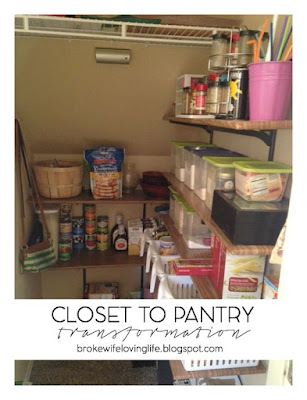Hello!
I know it's been forever since I've posted, going back to work has been exhausting! We actually completed this project before we even moved in to our house, but I figured it was a good one to share!
Our kitchen has a pantry but it's the standard tiny 3 foot wide and 2 foot deep kind. Since we don't have a ton of cabinet space, the real pantry houses all our appliances...crockpot, blender, and such.
We considered making a food storage area in the garage, but that would mean I would have to walk an extra 30 feet to get what I want and lets be real, that's not ideal. Instead, we decided to transform our coat closet under the stairs into our pantry. It's conveniently located in the kitchen and was really a huge waste of space.
We bought these tracks and these brackets from Home Depot and a sheet of particle board to make the shelves. We measured the width of the closet and decided how long we wanted our shelves. We did one 12" deep shelf, 8" deep on the others and 6" deep on the top one. We brought the measurements to Home Depot and they cut our shelves for us. Unfortunately, they're not exactly precise...but we don't have a saw so we made it work (just required some sanding and light hammering...).
Now, particle board isn't exactly glamorous looking, but I'm cheap...the nice shelves are like eight bucks a piece...no thanks. So I picked up some wood grain contact paper and wrapped the shelves like a present...I just stapled the paper on with a staple gun.
Containers are the key to a nicely organized pantry. When your pantry is organized it's way easier to see (and know) what you have, so you don't end up with 3 things of baking powder. I bought some of the containers at Walmart for a couple bucks and even got a bunch at Dollar Tree. I find that things fit much easier if you empty them from their bag and into a container. Each one is labeled, I have one for each of the standard baking items and then some that hold things like rice, tea, drink mixes, breakfasts, etc. We also installed a little motion sensing light to the ceiling since there wasn't an existing light.
I also have some baskets for the random stuff like crackers and chips and all my big plastic cups and water bottles.
I also have a little three drawer thing that holds baking accessories like sprinkles and food coloring. It's nice to have them easy to find and not having to dig through everything to find them since they're so small.
In addition to the shelving, we have a door rack that holds my Spark and protein mix I use everyday, paper towels and cleaning stuff. We hung a rack for brooms and such that also holds the dogs' leashes. I believe I got both of those at Walmart.
I also hang up my purses on a cup hook, it's nice to have them nearby but out of sight. I usually have everything in my Thirty One Bag I use for school but sometimes I need to make a quick switch to a smaller purse. I also hang up my running belt and stash our hats on the existing wire shelf.
We probably spent around $50 for the shelving, tracks and brackets, well worth it for all the extra storage. The white containers with handles are $2.47 a piece at Walmart and the square plastic containers with the blue and green lids are from Dollar Tree...I'm pretty sure they came in two packs, but I got them a couple years ago. Adding the pantry space under the stairs has got to be one of my favorite thing we did at the house, it has been so practical and useful!



















































